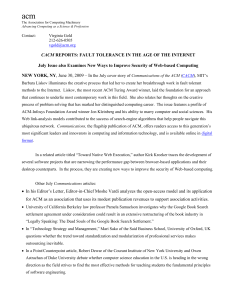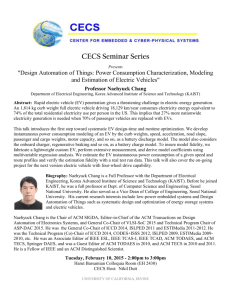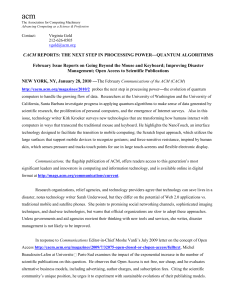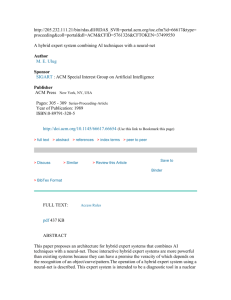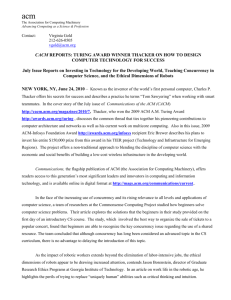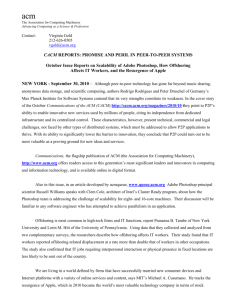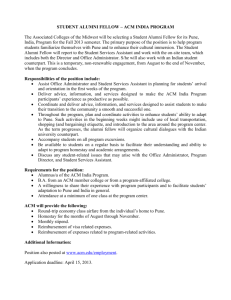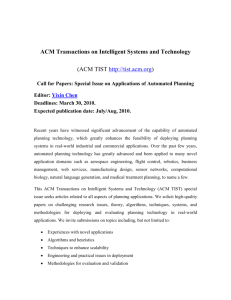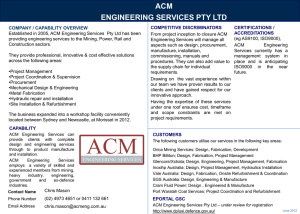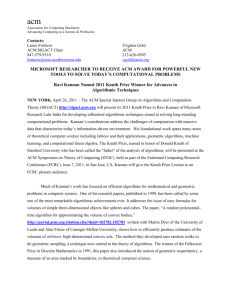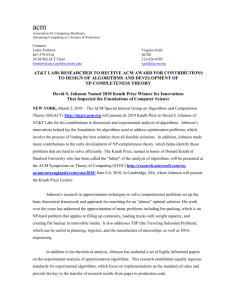Click here to get the file
advertisement
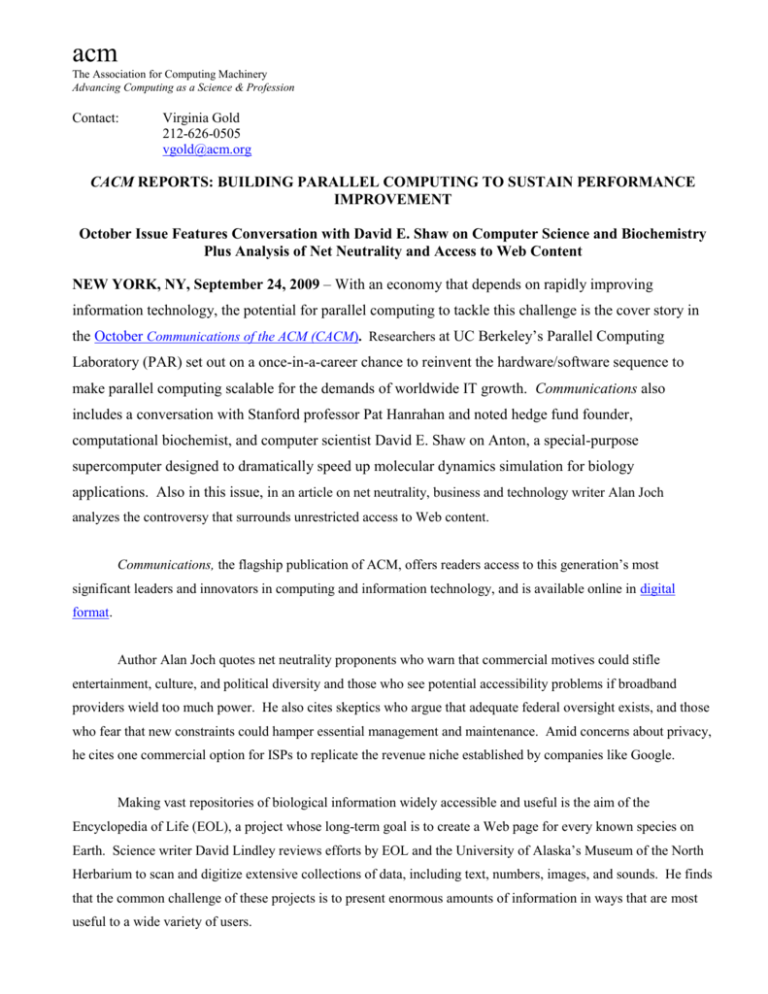
acm The Association for Computing Machinery Advancing Computing as a Science & Profession Contact: Virginia Gold 212-626-0505 vgold@acm.org CACM REPORTS: BUILDING PARALLEL COMPUTING TO SUSTAIN PERFORMANCE IMPROVEMENT October Issue Features Conversation with David E. Shaw on Computer Science and Biochemistry Plus Analysis of Net Neutrality and Access to Web Content NEW YORK, NY, September 24, 2009 – With an economy that depends on rapidly improving information technology, the potential for parallel computing to tackle this challenge is the cover story in the October Communications of the ACM (CACM). Researchers at UC Berkeley’s Parallel Computing Laboratory (PAR) set out on a once-in-a-career chance to reinvent the hardware/software sequence to make parallel computing scalable for the demands of worldwide IT growth. Communications also includes a conversation with Stanford professor Pat Hanrahan and noted hedge fund founder, computational biochemist, and computer scientist David E. Shaw on Anton, a special-purpose supercomputer designed to dramatically speed up molecular dynamics simulation for biology applications. Also in this issue, in an article on net neutrality, business and technology writer Alan Joch analyzes the controversy that surrounds unrestricted access to Web content. Communications, the flagship publication of ACM, offers readers access to this generation’s most significant leaders and innovators in computing and information technology, and is available online in digital format. Author Alan Joch quotes net neutrality proponents who warn that commercial motives could stifle entertainment, culture, and political diversity and those who see potential accessibility problems if broadband providers wield too much power. He also cites skeptics who argue that adequate federal oversight exists, and those who fear that new constraints could hamper essential management and maintenance. Amid concerns about privacy, he cites one commercial option for ISPs to replicate the revenue niche established by companies like Google. Making vast repositories of biological information widely accessible and useful is the aim of the Encyclopedia of Life (EOL), a project whose long-term goal is to create a Web page for every known species on Earth. Science writer David Lindley reviews efforts by EOL and the University of Alaska’s Museum of the North Herbarium to scan and digitize extensive collections of data, including text, numbers, images, and sounds. He finds that the common challenge of these projects is to present enormous amounts of information in ways that are most useful to a wide variety of users. In their Gödel Prize-winning paper, Daniel A. Spielman of Yale University and Shang-Hua Teng of Boston University explain the behavior of algorithms in practice. They point to the discrepancies between the theoretical evaluation of an algorithm and its practical performance and trace the steps toward modeling real data. The grand challenge facing algorithms, they conclude, is developing a means for predicting the performance of algorithms and experience-based techniques or heuristics on real data and on real computers. Other October Communications articles: ACM President Wendy Hall reports on ACM’s impressive strides toward her priority to increase ACM’s relevance and influence as a membership organization in the global computing community with internationalization initiatives involving the major technology hubs of Europe, India, and China. Examples of the upward or downward spiral of behaviors in the workplace are presented by Corvus International consultant Phillip G. Armour in an article on infectious behavior that pervades the business of software, and how to break the cycle of perennial overcommitments. Phillip Porras of SRI International presents an insider’s view of the analysis and implications of the Conficker conundrum, a sequence of malicious software attacks that initially exploited a flaw in Microsoft software. In a Q& A by technology writer Leah Hoffman, 2008 ACM-Infosys Foundation Award winner Jon Kleinberg talks about algorithms, information flow, and the connections between Web search and social networks. C.A.R. Hoare, renowned British computer scientist and recipient of the 1980 ACM Turing Award for his contributions to the definition and design of programming languages, revisits his past Communications article on the axiomatic approach to programming and uses it as a touchstone for the future. At BLOG@CACM, Greg Linden writes about machine learning and the $1 million Netflix Software Prize; Judy Robertson offers suggestions about getting teenagers interested in computer science; and Michael Conover discusses mobile phone usage and quick response codes in Japan. For more information on Communications of the ACM, click on http://cacm.acm.org/ . About ACM ACM, the Association for Computing Machinery www.acm.org, is the world’s largest educational and scientific computing society, uniting computing educators, researchers and professionals to inspire dialogue, share resources and address the field’s challenges. ACM strengthens the computing profession’s collective voice through strong leadership, promotion of the highest standards, and recognition of technical excellence. ACM supports the professional growth of its members by providing opportunities for life-long learning, career development, and professional networking. # # #

